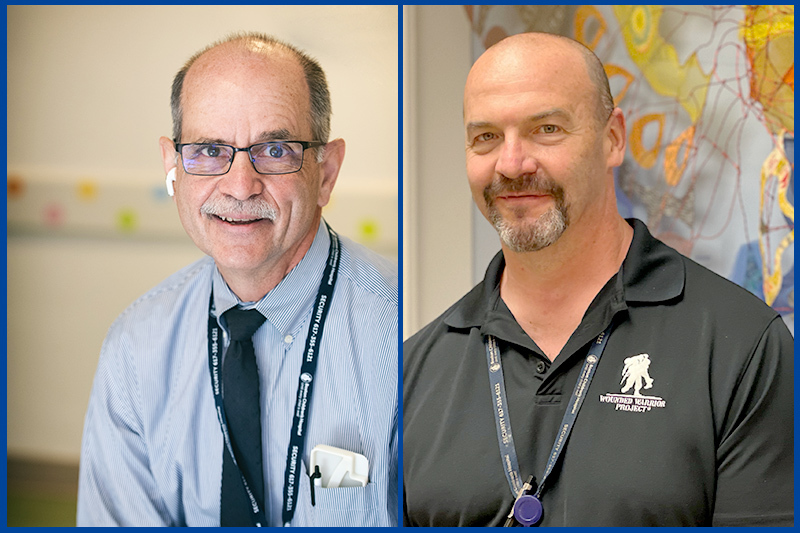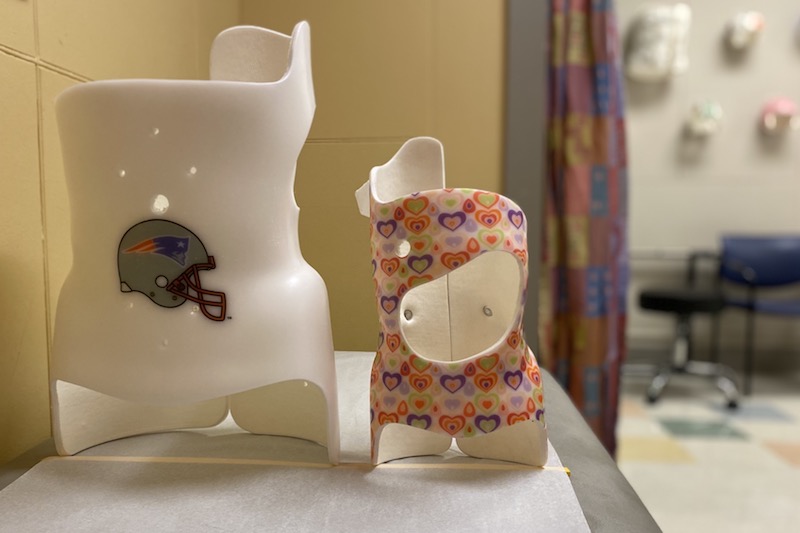A modified brace and a new treatment option for infantile scoliosis

While bracing is a common treatment for adolescents with moderate idiopathic scoliosis, infantile scoliosis is typically treated with casting. But putting an infant in a cast requires general anesthesia, which carries risks. And children must remain in their casts 24/7, for weeks or months at a stretch. Parents can only give them a full bath when the cast is changed, and each new cast requires more anesthesia.
For the past several years, Dr. Timothy Hresko of the Boston Children’s Hospital Spine Division and James “Rusty” Miller of Boston Orthotics and Prosthetics, have worked to modify adolescent brace designs for much younger patients. Through trial and error, and with feedback from patient families, they have used these altered braces to successfully treat several children with infantile scoliosis.
Here, they answer questions about infantile scoliosis and how braces are becoming an option for their youngest patients.
What led up to your use of bracing for infantile scoliosis?
Dr. Hresko: This is something Rusty and I have been working on since about 2017. We were motivated by our youngest patients, many of whom are less than a year old when they are first diagnosed with scoliosis. Their parents are told the only way to correct their child’s spine is with casting, but this requires them to be put under general anesthesia. I thought there must be a way to make a brace that would work for infants so anesthesia would not be necessary.
How did you modify scoliosis braces for infants?
Rusty Miller: The first braces we made for infants had small openings in front. Over time, we recognized that babies need more space for their bellies and rib cages to expand. We’ve opened the brace up quite a bit to allow for that to happen. We’ve also trimmed the brace to make it possible for kids to play while sitting on the floor and created more room around the thighs and hips to make diaper changing easier.

Is there an ideal age to start treatment for infantile scoliosis?
Dr. Hresko: With infantile scoliosis, you get a better result the sooner bracing starts, ideally around 12 to 18 months. Some kids come in for the first time when they are older (2 or 3 years), and their curves are already quite large. In those cases, the curve may be too much for a brace. We can try straightening the spine with a cast, but often these patients need surgery.
How do you make sure the brace will fit properly?
Miller: Each brace is tailor made for the patient. For older kids, we use computer-aided design technology to scan the child’s torso. But the patient has to hold still while we scan them, and most infants won’t do that. So, for very young patients, we make a plaster mold. Once we have a digital or plaster mold, we use computer-aided manufacturing to make a custom brace that places pressure in the right places to support the torso and slowly straighten the spine.
Even with these technologies, I often adjust the brace after it’s made to ensure it’s as comfortable as possible. Parents should watch for signs of skin irritation or discomfort. If there’s a problem, I want them to contact me right away so I can create more space as needed. The brace has to be worn for it to work. If the brace is uncomfortable, the child will probably wear it less.
How often do you see patients with infantile scoliosis?
Dr. Hresko: After a patient is fitted for their brace, I’ll see them once a month for the first three months. These visits are a chance for me to monitor the curve and check in with the family. The newer braces have heat sensors that track how many hours per day a child is wearing the brace. We can review this information together and if a family is struggling, I can offer additional support and coaching.
Over time, families can come in less often: every two, three, or even six months, depending on the child and their stage of growth. Generally, children with infantile scoliosis need to continue wearing a brace until they are 4 or 5 years old. Because children grow so rapidly during this time, our patients outgrow their braces and need new ones about six times through the course of their treatment.
Is casting ever a better option than bracing for children with infantile scoliosis?
Dr. Hresko: For bracing to be effective, the family has to be committed to keeping their child in the brace for the prescribed amount of time and coming in for regular visits. It takes time for children to adjust to wearing a brace. If parents are going to remove the brace any time their child gets fussy, casting is probably a better option.
How do Boston Children’s Spine Division and Boston Orthotics & Prosthetics work together to treat scoliosis?
Miller: Our clinics in Boston and Waltham are in the same building as the Spine Division. If Dr. Hresko or another spine doctor has a patient who may benefit from bracing, they call us. Usually we can come right over to meet the patient in person. Often we can take measurements and start fitting the child for a brace that same day.
Learn more about the Spine Division.
Related Posts :
-

A new treatment option for Jeanne’s infantile scoliosis
If it hadn’t been for the pandemic, Jeanne McDaniel’s treatment for infantile scoliosis would have started when she ...
-

Beating the odds and neuromuscular scoliosis: Colin’s story
Colin Newton has a way of surprising people. Born with a rare neuromuscular disorder, he spent the first three months ...
-

Scoliosis bracing: How to support your child
Q&A with M. Timothy Hresko, MD and Deborah Cranford, RN Most patients with idiopathic scoliosis will never need ...
-

Congenital scoliosis: Maria’s story
Growing up in a big family helped. When Maria Dupuis came home from the hospital after surgery to correct her ...





